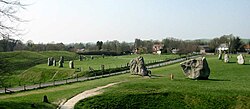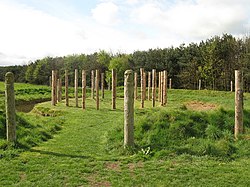Henge

A henge is a Neolithic earthwork. Henges are typical of the British Isles (for example Stonehenge), but there are a few similar structures in continental Europe.
Henges have a ring bank and ditch. They are not thought to be primarily defensive, because their ditch is inside the wall or rampart. For defence, it would seem better to have the ditch outside the bank. That way, attackers would need to climb up further. Their function is thought to be mainly ceremonial. This is discussed often in relation to Stonehenge.
Henges are divided into three types:
- Henge (≥20 m). There is usually little evidence of occupation in a henge, although they may contain ritual structures such as stone circles, timber circles and standing stones. Examples of henges are at
- Avebury, in Wiltshire, which contains the largest stone circle in Britain,
- The Great Circle at Stanton Drew in Somerset, which contains the second largest stone circle in Britain.
- The Ring of Brodgar in Orkney, which contains the third largest stone circle in Britain.
- Notes: example of henges without other significant internal monuments are the three henges of Thornborough Henges in Yorkshire. Stonehenge is not a typical henge because the ditch is outside the main earthwork bank.
- Mini henge (<20 m). Like an ordinary henge, except the central flat area is less than 20 m in diameter. An example is the Neolithic site at Dorchester on Thames.
- Henge enclosure (>300 m). A Neolithic ring earthwork with the ditch inside the bank, with the central flat area having abundant evidence of occupation and being more than 300 metres in diameter. Some true henges are as large as this (e.g., Avebury), but lack evidence of domestic occupation. Examples of henge enclosures are Durrington Walls in Wiltshire, and Mount Pleasant Henge in Dorset.
Henge Media
Avebury henge contains several stone circles
The Ring of Brodgar, Orkney, is a possible area of origin for henges
Excavated henge ditch on Wyke Down (Dorset). The ditch was originally dug as a causewayed enclosure and may therefore not be a henge.
Source
- Malone, Caroline. 2005. Neolithic Britain and Ireland. Tempus, Stroud, Gloucestershire.



